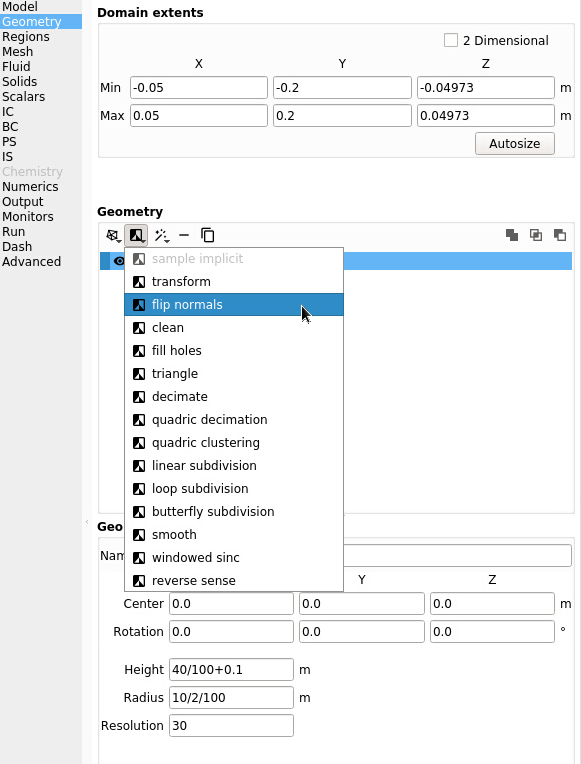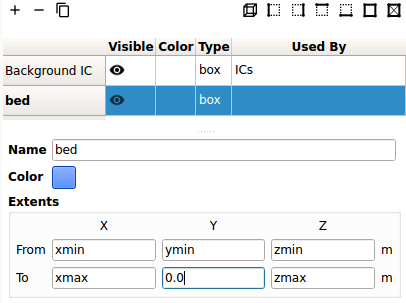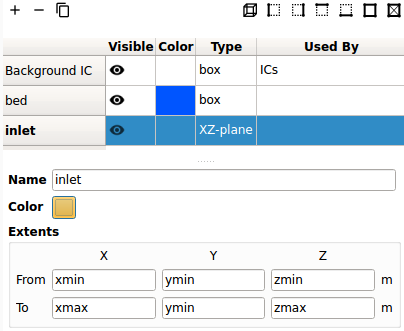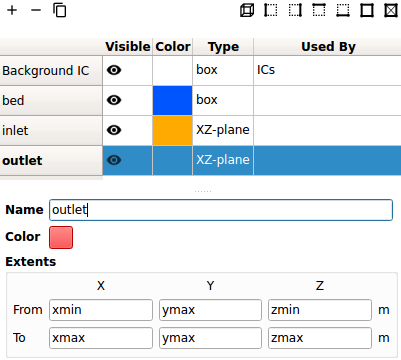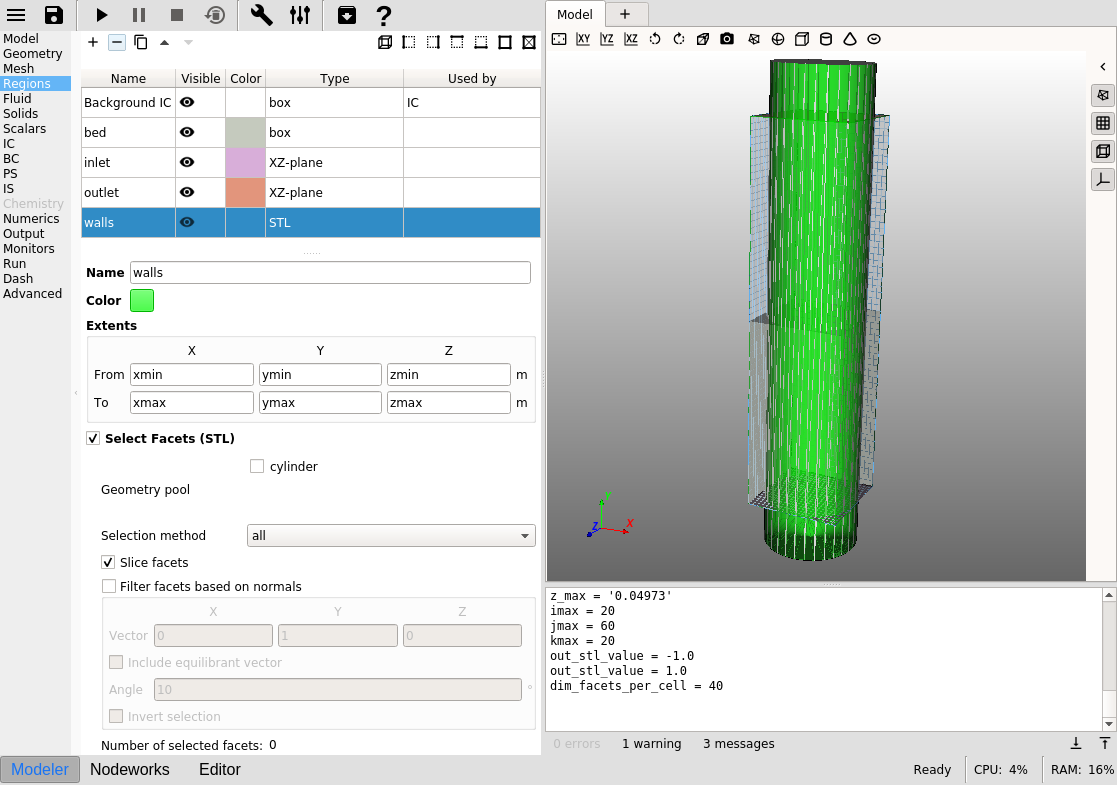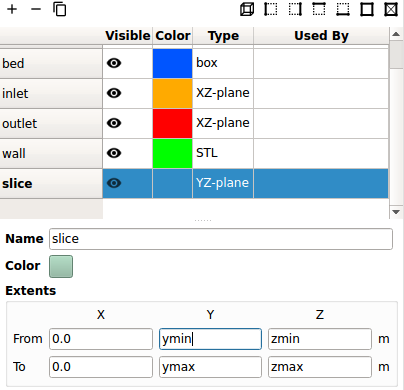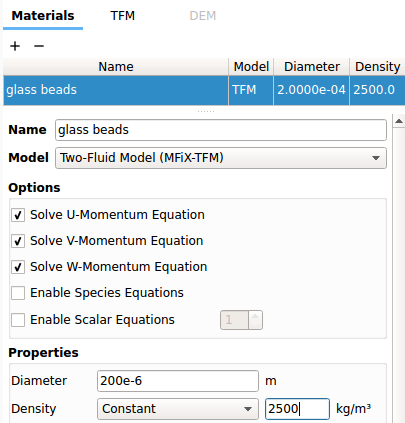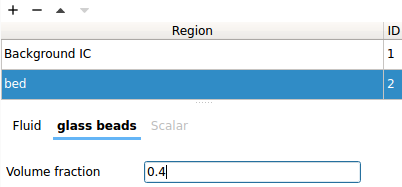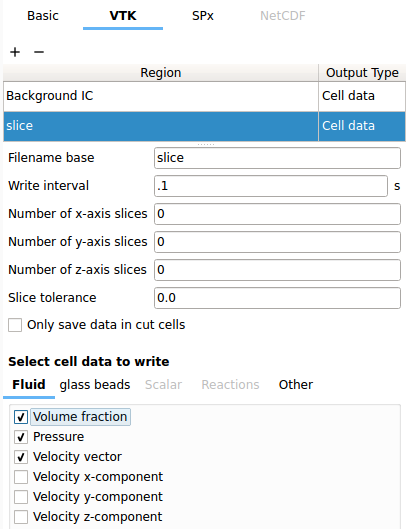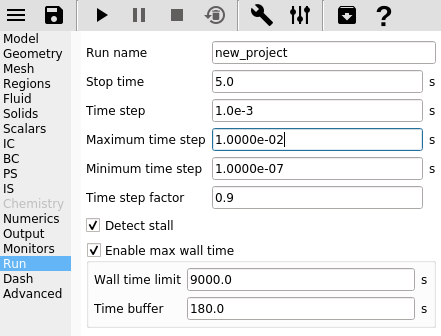3.5. Three-dimensional fluidized bed¶
This tutorial shows how to create a three dimensional fluidized bed simulation using the two-fluid model (TFM) and the discrete element model (DEM). The model setup is:
Property |
Value |
|---|---|
geometry |
10 cm diameter x 40 cm |
mesh |
20 x 60 x 20 |
solid diameter |
200 microns (\(200 \times 10^{-6}\) m) |
solid density |
2500 kg/m2 |
gas velocity |
0.25 m/s |
temperature |
298 K |
pressure |
101325 Pa |
3.5.1. Create a new project¶
On the main menu, select
New projectCreate a new project by double-clicking on “Blank” template.
Enter a project name and browse to a location for the new project.
When prompted to enable SMS workflow, answer No, we will use the standard workflow for this tutorial.
3.5.2. Select model parameters¶
On the Model pane:
Enter a descriptive text in the
DescriptionfieldSelect “Two-Fluid Model (MFiX-TFM)” in the
Solverdrop-down menu.
3.5.3. Enter the geometry¶
On the Geometry pane:
Create the cylindrical geometry by pressing the
Add Geometrybutton ->Primitives->cylinder
Enter
40/100meters for the cylinder heightEnter
10/2/100meters for the cylinder radiusEnter
30for the cylinder resolutionPress the autosize button to fit the domain extents to the geometry
Extend the height of the cylinder by adding
0.1meters. This will hang the stl file outside of the domain, allowing for a sharp and clean cut.Flip the normals by clicking the
button and selecting the
flip normalsfilter
3.5.4. Enter the mesh¶
On the Mesh pane:
On the
Backgroundsub-pane
Enter
20for the x cell valueEnter
60for the y cell valueEnter
20for the z cell value
Note
This is a fairly coarse grid for a TFM simulation. After completing this tutorial, try increasing the grid resolution to better resolve the bubbles.
3.5.5. Create regions for initial and boundary condition specification¶
Select the Regions pane. By default, a region that covers the entire domain
is already defined. This is typically used to initialize the flow field and
visualize the results.
Click the
(all) button to create a new region to be used for the bed initial condition.
Enter a name for the region in the
Namefield (“bed”)Change the color by pressing the
ColorbuttonEnter
0in theTo Yfield
Click the
(bottom) button to create a new region to be used by the gas inlet boundary condition.
Enter a name for the region in the
Namefield (“inlet”)
Click the
(top) button to create a new region to be used by the pressure outlet boundary condition.
Enter a name for the region in the
Namefield (“outlet”)
Click the
(all) button to create a new region to be used to select the walls.
Enter a name for the region in the
Namefield (“walls”)Click the
Select facetsbox. The region type should change from “box” to “STL”.
All the facets of the cylinder should now be selected. Since the cylinder is outside the domain extents, normal cells (i.e. not cut-cells) will be placed at the outlet and inlet. This allows for the standard boundary conditions to be applied.
Click the
(left) button to create a new region to be used to save a slice of cells at the center of the domain.
Enter a name for the region in the
Namefield (“slice”)Enter
0in theFrom XandTo Xfields
3.5.6. Create a solid¶
On the Solids pane:
Click the
button to create a new solid
Enter a descriptive name in the
Namefield (“glass beads”)Accept the radial distribution setting (Carnahan-Starling)
Enter the particle diameter of
200e-6m in theDiameterfieldEnter the particle density of
2500kg/m2 in theDensityfield
3.5.7. Create Initial Conditions¶
On the Initial conditions pane:
Select the already populated “Background IC” from the region list. This will initialize the entire flow field with air.
Enter
101325Pa in thePressure (optional)fieldCreate a new Initial Condition by pressing the
button
Select the region created previously for the bed Initial Condition (“bed” region) and click the
OKbutton.Select the solid (named previously as “glass beads”) sub-pane and enter a volume fraction of
0.4in theVolume Fractionfield. This will fill the bottom half of the domain with glass beads.
3.5.8. Create Boundary Conditions¶
On the Boundary conditions pane:
Create a new Boundary condition by clicking the
button
On the
Select regiondialog, select “Mass Inflow” from theBoundary typedrop-down menuSelect the “inlet” region and click
OKOn the
Fluidsub-pane, enter a velocity in theY-axial velocityfield of0.25m/sCreate another Boundary condition by clicking the
button
On the
Select regiondialog, select “Pressure outflow” from theBoundary typecombo-boxSelect the “outlet” region and click
OK
Note
The default pressure is already set to 101325 Pa, no changes need to be made to the outlet boundary condition.
Create another Boundary condition by clicking the
button
On the
Select regiondialog, select “No Slip Wall” from theBoundary typecombo-boxSelect the “wall” region and click
OK
3.5.9. Change numeric parameters¶
On the Numerics pane, Residuals sub-pane:
Enter
0in theFluid Normalizationfield.
3.5.10. Select output options¶
On the Output pane:
On the
Basicsub-pane, check theWrite VTK output files (VTU/VTP)checkboxSelect the
VTKsub-paneCreate a new output by clicking the
button
Select the “Background IC” region from the list to save all the cell data
Click
OKto create the outputEnter a base name for the
*.vtufiles in theFilename basefieldChange the
Write intervalto0.01secondsSelect the
Volume fraction,Pressure, andVelocity vectorcheckboxes on theFluidtabCreate another output by clicking the
button
Select the “Slice” region from the list to save all the cell data
Click
OKto create the outputEnter a base name for the
*.vtufiles in theFilename basefieldChange the
Write intervalto0.01secondsSelect the
Volume fraction,Pressure, andVelocity vectorcheckboxes on theFluidtab
3.5.11. Change run parameters¶
On the Run pane:
Change the
Stop timeto1.0secondsChange the
Time stepto1e-3secondsChange the
Maximum time stepto1e-2seconds
3.5.12. Run the project¶
Save project by clicking
button
Run the project by clicking the
button
On the
Rundialog, select the default executable from the listClick the
Runbutton to actually start the simulation
3.5.13. View results¶
Results can be viewed, and plotted, while the simulation is running.
Create a new visualization tab by pressing the
next to the Model tab
Select an item to view, such as plotting the time step (dt) or click the
3D viewbutton to view the vtk output files.On the
VTKresults tab, the visibility and representation of the*.vtkfiles can be controlled with the menu on the side.
3.5.14. Convert this project into a 3D DEM simulation¶
Click the
button and delete all simulation files.
Close the VTK window
On the
Modelpane, change the solver toMFiX-DEMOn the
Meshpane, coarsen the grid to 15, 45, and 15 cells in the in the x, y, and z direction, respectfully.
Note
The grid resolution needs to be coarser because we are drastically increasing the particle diameter below. The fluid grid cell size has to be bigger than the particle size.
On the
Solidspane, change that particle diameter to5.0000e-03to get a more reasonable particle count for tutorial purposes.On the
Solidspane,DEMsub-pane: - check theEnable automatic particle generation- enter a value of15in theSearch grid partitions,KMAXfield.On the
Boundary Conditionspane, change theinletY-axial velocityto0.6m/sOn the
Boundary Conditionspane, delete thewallsboundary condition and re-add it to write the correct wall parameters for the DEM simulation.On the
Outputpane,VTKsub-pane:Delete the
allorBackground_ICoutputCreate a new output, change the
Output typetoParticle dataand select theBackground_ICregion.Change the write frequency to
0.01Select the
DiameterandTranslational Velocitydata
Run the simulation
Create a VTK window to visualize the data. It will automatically show the slice (cell data) and the particles.



